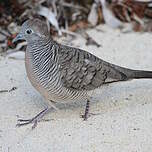Zebra Dove
Geopelia striata - Géopélie zébrée
Identification
The Zebra Dove, belonging to the Columbidae family, is a tiny but very pretty dove. It is even the smallest among the other doves of its species. It is similar to the Peaceful Dove but its colors are brighter. The back of the head, the back, the wings, the rump and the tail are light gray-brown decorated with thin brown stripes that characterize it. The flanks and the chest are white-gray, zebra-striped too. A wide rosy chamois band starts from the throat and goes down to the lower abdomen while widening. This part remains unified. The forehead, the throat and the cheeks are light blue gray matching the color of the blue iris. The beak and the wax are blue-gray, the legs pink. A pale blue skin starts from the base of the beak and goes around the eye. In flight, the white edges of the rectrices are clearly visible. The male and the female are strictly identical. The juveniles look like the adults but with paler colors.
Subspecific information monotypic species
Foreign names
- Géopélie zébrée,
- Tortolita estriada,
- rola-zebrada,
- Sperbertäubchen,
- zebragalambocska,
- Zebraduif,
- Tortora zebrata,
- zebraduva,
- Sebradue,
- holúbok pásikavý,
- holoubek vlnkovaný,
- Zebradue,
- seeprakyyhky,
- tortoreta estriada,
- gołąbek zebrowany,
- Волосатая горлица,
- Perkutut jawa,
- チョウショウバト,
- 斑姬地鸠,
- นกเขาชวา,
- 斑姬地鳩,
Habitat
Behaviour character trait
The Zebra Dove lives alone or in pairs. In anthropized environments, it mixes very easily with populations and is not fearful at all; to the point that passing by it doesn't cause any disturbance.
On the other hand, populations living in forested areas far from cities remain very fearful. At the beginning of the day, it can stay in full sun with its wings deployed for long periods of time, trying to warm itself up. Its grayish plumage allows it to remain unseen on the ground, where it spends a lot of time looking for food. At night, the Zebra Doves gather in dormitories in large trees. They seem to particularly enjoy coconut trees.Dietfeeding habits
Reproduction nesting
The Zebra Dove reproduces from September to June. As with all columbids, the male courts with rapid bow movements while calling out to the female, fluffing its feathers. The female builds a platform nest made of small twigs and roots in a palm tree, a tree or a bush, and rarely on the ground. She lays one or two white eggs, which are incubated by both parents. The incubation period lasts between 13 and 18 days and the young fledge after two to three weeks.
Geographic range
The Zebra Dove is native to Asia and Australia. Its range extends from Southern Thailand to the Malaysian Peninsula. It can also be found in Borneo, Bali and the Philippine Islands.
It has been introduced to numerous islands in the Indian Ocean: the Seychelles, the Chagos Archipelago,Mauritius, Rodrigues, Reunion and Saint Helena as well as in French Polynesia.
Threats - protection
IUCN conservation status
concern
in the Wild
threatened
evaluated
The Zebra Dove is becoming increasingly rare in Indonesia due to repeated trapping in order to be sold as a cage bird and to compete in singing competitions. Elsewhere it remains common and is one of the most abundant bird species. Its overall population is not in decline.
Sources of information
- IOC World Bird List (v15.1), Gill, F and D Donsker (Eds). 2025-12-07.
- Oiseaux des iles de l'océan Indien, Langrand Olivier, ian Sinclair
- Wikipedia (English version),
- Wikipédia, Wikipedia, The Free Encyclopedia
- Société d'Etudes Ornithologiques de la Réunion ,
- BirdLife International, BirdLife International
Other sources of interest
 Specification sheet created on
25/07/2023 by Nathalie Santa Maria
Specification sheet created on
25/07/2023 by Nathalie Santa MariaTranslation by AI Oiseaux.net
© 1996-2025 Oiseaux.net
- Accipitriformes
- Aegotheliformes
- Anseriformes
- Apodiformes
- Apterygiformes
- Bucerotiformes
- Caprimulgiformes
- Cariamiformes
- Casuariiformes
- Charadriiformes
- Ciconiiformes
- Coliiformes
- Columbiformes
- Coraciiformes
- Cuculiformes
- Eurypygiformes
- Falconiformes
- Galliformes
- Gaviiformes
- Gruiformes
- Leptosomiformes
- Mesitornithiformes
- Musophagiformes
- Nyctibiiformes
- Opisthocomiformes
- Otidiformes
- Passeriformes
- Pelecaniformes
- Phaethontiformes
- Phoenicopteriformes
- Piciformes
- Podargiformes
- Podicipediformes
- Procellariiformes
- Psittaciformes
- Pterocliformes
- Rheiformes
- Sphenisciformes
- Steatornithiformes
- Strigiformes
- Struthioniformes
- Suliformes
- Tinamiformes
- Trogoniformes





























